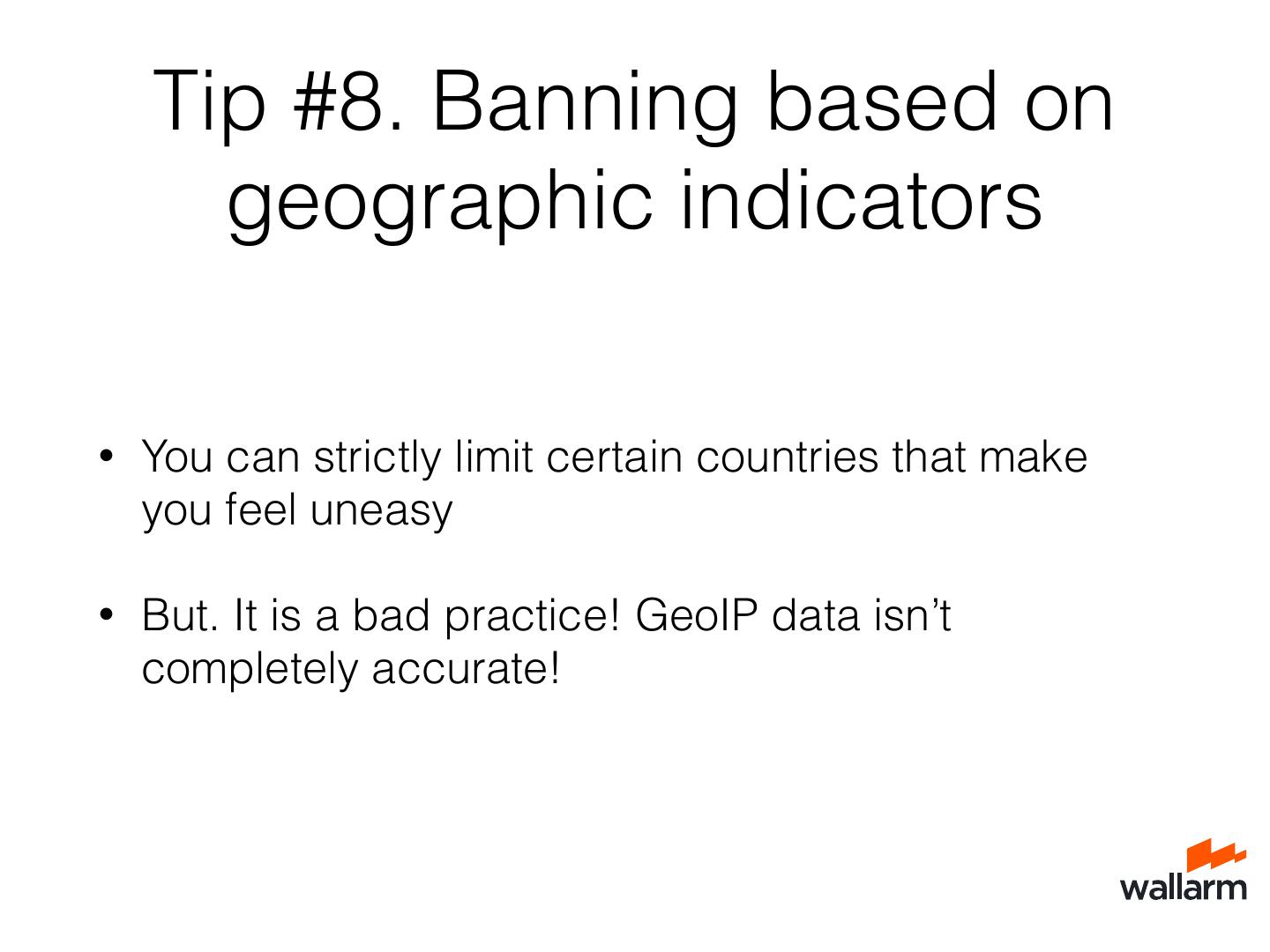- 快召唤伙伴们来围观吧
- 微博 QQ QQ空间 贴吧
- 文档嵌入链接
- 复制
- 微信扫一扫分享
- 已成功复制到剪贴板
用Ngnix打造安全网站
展开查看详情
1 .Securing Web Apps with NGINX http://wallarm.com Stephan Ilyin, si@wallarm.com
2 .How many of you have your websites hacked?
3 .Each application probably has vulnerabilities
4 .… and someday it can be hacked
5 .How to harder/secure your application?
6 .How deal with attacks to your application? Chapter 1.
7 .Tip #1. mod_security can be a good choice
8 . Mod_security rocks! • Open-source. Finally available for NGINX • It works! It can be quite efficient in detecting attacks • Supports virtual patching • It is incredible customisable
9 .server { listen 80; server_name localhost; location / { ModSecurityEnabled on; ModSecurityConfig modsecurity.conf; ModSecurityPass @backend; } location @backend { proxy_pass http://localhost:8011; proxy_read_timeout 180s; } }
10 . but mod_security is not so good! • Relies on regex • It is expensive in performance prospective • If you use default rulesets, you will get a huge number of false-positives • Rules tuning is a hard job (difficult to maintain) • Signatures never covers all the attacks • REGEXs can be bypassed
11 . What rules look like # ShellShock virtual patch (Bash attack) SecRule REQUEST_HEADERS "^\(\s*\)\s+{" "phase:1,deny,id: 1000000,t:urlDecode,status: 400,log,msg:'CVE-2014-6271 - Bash Attack'"
12 . Good practice (imho) • Use public ruleset — for monitoring mode • Craft rules from scratch specifically for your application — for blocking mode
13 . More rules = More overhead!
14 .Using phases is good idea 1. Request headers (REQUEST_HEADERS) 2. Request body (REQUEST_BODY) 3. Response headers (RESPONSE_HEADERS) 4. Response body (RESPONSE_BODY) 5. Logging (LOGGING)
15 . SecRule phase 2 SecRule REQUEST_BODY "/+etc/+passwd" "t:none,ctl:ResponseBodyAccess=On,msg:'- IN- PASSWD path detected', phase: 2,pass,log,auditlog,id:'10001',t:urlDeco de,t:lowercase,severity:1"
16 . SecRule phase 4 SecRule RESPONSE_BODY "root\:x\:0\:0" "id:'20001',ctl:auditLogParts=+E, msg:'- OUT- Content of PASSWD detected!',phase: 4,allow,log,auditlog,t:lowercase,severit y:0"
17 .Handbook by Ivan Ristic. Must read!
18 .Tip #2. Give a chance to naxsi (another WAF for NGINX)
19 . Why naxsi? • NAXSI means Nginx Anti Xss & Sql Injection (but do more) • Naxsi doesn't rely on a signature base (regex)! https://github.com/nbs-system/naxsi
20 . naxsi rules • Reads a small subset of simple scoring rules (naxsi_core.rules) containing 99% of known patterns involved in websites vulnerabilities. • For example, '<', '|' or 'drop' are not supposed to be part of a URI.
21 . This rule triggers on select or other SQL operators MainRule "rx:select|union|update|delete| insert|table|from|ascii|hex|unhex|drop" "msg:sql keywords" "mz:BODY|URL|ARGS| $HEADERS_VAR:Cookie" "s:$SQL:4" id:1000;
22 . naxsi setup http { include /etc/nginx/naxsi_core.rules; include /etc/nginx/mime.types; [...] }
23 .But! Ruleset is not enough! • Those patterns may match legitimate queries! • Therefore, naxsi relies on whitelists to avoid false positives • Nxutil tool helps the administrator to create the appropriate whitelist • there are pre-generated whitelists for some CMS (e.g. WordPress)
24 . LearningMode; #Enables learning mode SecRulesEnabled; #SecRulesDisabled; DeniedUrl "/RequestDenied"; ## check rules CheckRule "$SQL >= 8" BLOCK; CheckRule "$RFI >= 8" BLOCK; CheckRule "$TRAVERSAL >= 4" BLOCK; CheckRule "$EVADE >= 4" BLOCK; CheckRule "$XSS >= 8" BLOCK;
25 .naxsi ruleset
26 .naxsi whitelist
27 . Naxsi pros and cons Pros: • Pretty fast! • Update independent • Resistant to many waf-bypass techniques Cons: • You need to use LearningMode with each significant code deployment
28 . Tip #3. Try repsheet (behaviour based security)
29 .Watch Aaron Bedra’s talk http://getrepsheet.com/






















































































